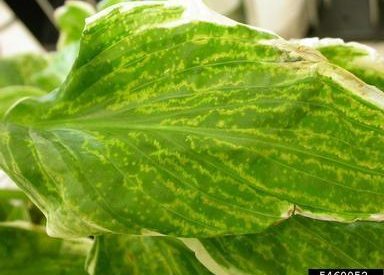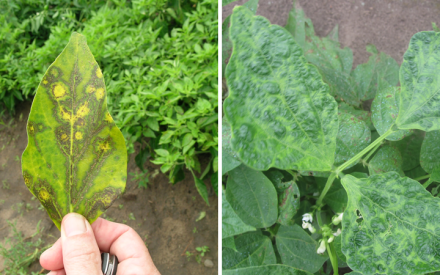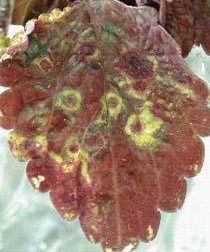
What is tobacco rattle?
Tobacco rattle is a common and potentially serious viral disease that affects a variety of herbaceous ornamentals including, but not limited to, astilbe, bleeding heart, coral bells, daffodil, epimedium, gladiolus, hyacinth, marigold, tulip and vinca. Tobacco rattle can also affect vegetable crops such as beans, beets, peppers, potatoes, and spinach. On potatoes, the disease is referred to as corky ring spot and can make affected potato tubers unmarketable.
What does tobacco rattle look like?
Symptoms of tobacco rattle can vary depending on the plant species or variety/cultivar affected, and depending on environmental conditions. Infected plants may exhibit mottling (i.e., blotchy light and dark discoloration of leaf tissue), yellow ring spots or line patterns, localized chlorotic (i.e., yellow) spots or streaks, necrotic lesions (i.e., dead spots), or leaves with notches. Leaf discoloration symptoms are often quite attractive and can be misidentified as variegation, a natural variation in leaf color due to plant genetics. Plants that become infected with TRV at a young age can exhibit a variety of leaf and stem deformities. In potato, the disease typically manifests itself as a series of necrotic, corky spots, arcs or rings in tuber tissue.
Where does tobacco rattle come from?
Tobacco rattle is caused by the Tobacco rattle virus (TRV). The virus is often introduced into a landscape in infected plants. Once established in a location, the virus can be spread to other plants by stubby-root nematodes, a group of microscopic, worm-like organisms in the genera Trichodorus and Paratrichdorus. These nematodes feed on the roots of infected plants, acquiring TRV, then move to non-infected plants where their subsequent feeding spreads the virus. TRV also can be spread from plant to plant mechanically when pruning tools (e.g., shovels, trowels, knives, pruners) that are used to trim or divide plants become contaminated with the sap from infected plants. Grafting is another means by which the virus can be transmitted. Finally, TRV can be found in seeds from infected plants.

How do I save a plant with tobacco rattle?
Once plants have become infected with TRV, they remain infected indefinitely. Infected plant cannot be treated in any way to eliminate the virus. They should be removed and disposed of by burning (where allowed by local ordinance), burying or hot composting.
How do I avoid problems with tobacco rattle in the future?
The best way to prevent problems with tobacco rattle is to grow plants that are not susceptible to TRV. Such plants include, but are not limited to, annual phlox, carnation, sweet William, zinnia and plants in the genus Datura (e.g., devil’s trumpet, downy thorn-apple, zombie cucumber). Before buying either annual or perennial ornamentals, carefully inspect plants susceptible to TRV for symptoms caused by the virus. Do not buy symptomatic plants. Keep in mind however, that infected plants may not show symptoms at all times.
To prevent mechanical spread of TRV when pruning or dividing plants, decontaminate tools by treating them for a minimum of one minute with:
- 2.75 tablespoons Alconox® (a lab detergent) plus 2.5 tablespoons sodium lauryl sulfate (SLS), also known as sodium dodecyl sulfate (SDS), in one gallon of water, or
- 14 dry ounces of trisodium phosphate in one gallon of water.
These ingredients can be ordered on the internet. If you decide to use SLS (SDS), be sure to wear gloves, safety goggles and a dust mask, and mix the solution in a well-ventilated area as SLS (SDS) is a known skin and eye irritant. Once treated, rinse tools with sufficient water to remove any residues. Also, when working with plants, thoroughly wash your hands on a regular basis with soap and water to deactivate any of the virus you may pick up on your hands.
Control of the nematodes that transmit TRV is not practical in home garden settings and is not recommended.
For more information on tobacco rattle:
Contact the University of Wisconsin Plant Disease Diagnostics Clinic (PDDC) at (608) 262-2863 or pddc@wisc.edu.
Authors: Rachel Zwieg* and Brian Hudelson, UW-Madison Plant Pathology
Last Revised: 03/02/2024
D-number: D0116
* Completed as partial fulfillment of the requirements for the Horticulture track of the Farm and Industry Short Course program at the University of Wisconsin Madison.
References to pesticide products in this publication are for your convenience and are not an endorsement or criticism of one product over similar products. You are responsible for using pesticides according to the manufacturer’s current label directions. Follow directions exactly to protect the environment and people from pesticide exposure. Failure to do so violates the law.
Thanks to Amy Charkowski, Russell Groves and Tom German for reviewing this document, and to Anette Phibbs of the Wisconsin Department of Agriculture, Trade and Consumer Protection for providing the photo.
A complete inventory of UW Plant Disease Facts is available at the University of Wisconsin-Madison Plant Disease Diagnostics Clinic website: https://pddc.wisc.edu.
Send a Plant Sample for Analysis
Be cautious when self-diagnosing plant health issues. Very few diseases can accurately be diagnosed by eye.
Contact the UW Plant Disease Diagnostics Clinic (PDDC), and for a small fee, clinic staff can examine a plant, determine the cause of the disease/disorder, and provide advice on how to control or prevent the issue.
Download Article





 Corky Ringspot
Corky Ringspot Hosta Virus X
Hosta Virus X Cucumber Mosaic
Cucumber Mosaic Impatiens Necrotic Spot
Impatiens Necrotic Spot


